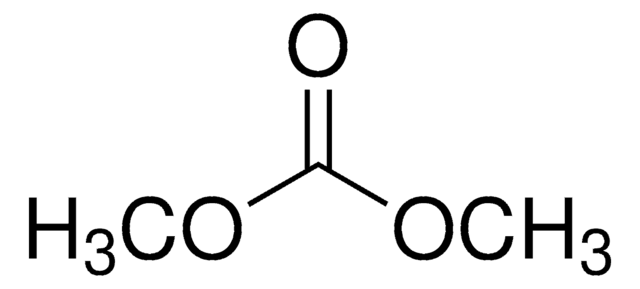Kluczowe dokumenty
439223
Dichloromethane
suitable for HPLC, ≥99.9%, contains 40-150 ppm amylene as stabilizer
Synonim(y):
Methylene chloride
About This Item
Polecane produkty
klasa czystości
HPLC grade
Poziom jakości
gęstość pary
2.9 (vs air)
ciśnienie pary
24.45 psi ( 55 °C)
6.83 psi ( 20 °C)
Próba
≥99.9%
Formularz
liquid
temp. samozapłonu
1223 °F
zawiera
40-150 ppm amylene as stabilizer
granice wybuchowości
22 %
metody
HPLC: suitable
zanieczyszczenia
Free halogens, passes test
≤0.0003 meq/g Titr. acid
≤0.02% water
pozostałość po odparowaniu
<0.0003%
kolor
APHA: ≤10
clear
współczynnik refrakcji
n20/D 1.424 (lit.)
bp
39.8-40 °C (lit.)
mp
−95 °C (lit.)
gęstość
1.325 g/mL at 25 °C (lit.)
λ
H2O reference
absorpcja UV
λ: 235 nm Amax: 1.00
λ: 240 nm Amax: 0.20
λ: 250 nm Amax: 0.05
λ: 260 nm Amax: 0.02
λ: 340-400 nm Amax: 0.01
przydatność
passes test for HPLC
ciąg SMILES
ClCCl
InChI
1S/CH2Cl2/c2-1-3/h1H2
Klucz InChI
YMWUJEATGCHHMB-UHFFFAOYSA-N
Szukasz podobnych produktów? Odwiedź Przewodnik dotyczący porównywania produktów
Opis ogólny
Zastosowanie
- Do komponowania kąpieli ultradźwiękowych do czyszczenia i ochrony powłoki aluminiowej nad ataktycznym PMMA (poli (metakrylan metylu)) do badań dielektrycznych.
- Przygotowanie biomolekuł sprzężonych z AMBF3 (amoniometylotrifluoroboran).
- Przygotowanie próbek do analizy GC-MS (chromatografia gazowa-spektrometria mas).
- Przygotowanie mieszaniny rozpuszczalników octanu amonu w połączeniu z izopropanolem, acetonitrylem i wodą do analizy spektralnej neutralnych lipidów.
- Ilościowe oznaczanie glutationu (GSH) i disiarczku glutationu (GSSG) w próbkach biologicznych metodą HPLC i spektrofotometrii.
- Jako ekstrahent dla 2,2-ditioetylo-4-(2′-pirydylo)-4-butyro-γ-laktonu.
Opakowanie
Jako światowy lider w dziedzinie odczynników laboratoryjnych nieustannie poszukujemy nowych sposobów optymalizacji bezpieczeństwa naszych produktów. Nowo opracowana konstrukcja butelki na rozpuszczalniki o pojemności 4 l jest wyposażona w zaawansowaną technologię uszczelniania, która eliminuje wycieki, dzięki czemu obsługa rozpuszczalników jest bezpieczniejsza i wygodniejsza niż kiedykolwiek wcześniej.
Zobacz wszystkie nowe funkcje tutaj!
Uwaga dotycząca przygotowania
Hasło ostrzegawcze
Warning
Zwroty wskazujące rodzaj zagrożenia
Zwroty wskazujące środki ostrożności
Klasyfikacja zagrożeń
Carc. 2 - Eye Irrit. 2 - Skin Irrit. 2 - STOT SE 3
Organy docelowe
Central nervous system
Kod klasy składowania
6.1D - Non-combustible acute toxic Cat.3 / toxic hazardous materials or hazardous materials causing chronic effects
Klasa zagrożenia wodnego (WGK)
WGK 2
Temperatura zapłonu (°F)
does not flash
Temperatura zapłonu (°C)
does not flash
Środki ochrony indywidualnej
Eyeshields, Faceshields, Gloves
Wykazy regulacyjne
Wykazy regulacyjne dotyczą głównie produktów chemicznych. Można w nich podawać ograniczoną liczbę informacji na temat produktów niechemicznych. Brak wpisu oznacza, że żaden ze składników nie znajduje się w wykazie. Użytkownik odpowiada za zagwarantowanie bezpiecznego i zgodnego z prawem stosowania produktu.
EU REACH Annex XVII (Restriction List)
Wybierz jedną z najnowszych wersji:
Masz już ten produkt?
Dokumenty związane z niedawno zakupionymi produktami zostały zamieszczone w Bibliotece dokumentów.
Nasz zespół naukowców ma doświadczenie we wszystkich obszarach badań, w tym w naukach przyrodniczych, materiałoznawstwie, syntezie chemicznej, chromatografii, analityce i wielu innych dziedzinach.
Skontaktuj się z zespołem ds. pomocy technicznej





